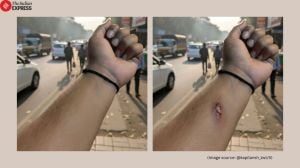More than eight months after the Karnataka government banned the wearing of the hijab in state pre-university colleges, triggering a row and spawning debates across the country, a two-judge bench of the Supreme Court delivered a split verdict Thursday.

The split verdict means that the matter will now be placed before the Chief Justice of India for further directions — it will likely go to a larger bench. And until the Supreme Court issues any direction, the ban on the hijab in Karnataka classrooms will remain in place.
Dismissing appeals against the March 15 verdict of the High Court which upheld the February 5 state order, Justice Gupta, who presided over the two-judge bench, said irrespective of whether the practice of wearing the hijab is a religious practice or essential religious practice or social conduct for the women of Islamic faith, the “interpretations by the believers of the faith about wearing of headscarf is the belief or faith of an individual”.
“The religious belief cannot be carried to a secular school maintained out of State funds. It is open to the students to carry their faith in a school which permits them to wear hijab or any other mark, may be tilak, which can be identified to a person holding a particular religious belief but the State is within its jurisdiction to direct that the apparent symbols of religious beliefs cannot be carried to school maintained by the State from the State funds. Thus, the practice of wearing hijab could be restricted by the State in terms of the Government Order,” Justice Gupta said.
 The media at the Supreme Court Thursday. (Express photo by Prem Nath )
The media at the Supreme Court Thursday. (Express photo by Prem Nath )
Justice Dhulia, on the other hand, said “a girl child has the right to wear hijab in her house or outside her house, and that right does not stop at her school gate. The child carries her dignity and her privacy even when she is inside the school gates, in her classroom. She retains her fundamental rights. To say that these rights become derivative rights inside a classroom, is wholly incorrect”.
Setting aside the High Court ruling, he also quashed the GO of February 5 which left it to College Development Committees (CDCs) to take a decision on the uniform to be followed.
Story continues below this ad
“We live in a Democracy and under the Rule of Law, and the Laws which govern us must pass muster the Constitution of India. Amongst many facets of our Constitution, one is Trust. Our Constitution is also a document of Trust. It is the trust the minorities have reposed upon the majority,” Justice Dhulia said.
Relying on arguments of the appellants that the controversy would lead to girls being denied education, he said, “This case therefore has also to be seen in the perspective of the challenges already faced by a girl child in reaching her school. The question this Court would therefore put before itself is also whether we are making the life of a girl child any better by denying her education, merely because she wears a hijab.”
Justice Gupta, however, said if the students were refusing to attend classes, it would not amount to denial of education by the state.
While the two judges steered clear of examining whether hijab is an essential religious practice, Justice Gupta said the GO does not impinge on the Constitutional promise of fraternity and dignity and “instead, it promotes an equal environment where such fraternal values can be imbibed and nurtured without any hindrance of any kind”.
Story continues below this ad
Justice Dhulia said the GO “and the restrictions on the wearing of hijab” also go “against our Constitutional value of fraternity and human dignity”.
Justice Gupta, who had framed 11 questions for consideration, said their answers went against the appellants. So, he said that the matter need not be referred to the nine-judge bench to which questions of law, arising out of review petitions in the Sabarimala case, have been referred, nor to a five-judge bench as demanded by the appellants.
Upholding the power of the state government to constitute CDCs under the Karnataka Education Act, 1983, Justice Gupta said “provisions show that the mandate of the statute is to renounce sectional diversities, to develop humanism and to cultivate scientific and secular outlook. The sectarian approach that certain students will carry their religious beliefs to secular schools run by the State would be antithesis of the mandate of the statute. All students need to act and follow the discipline of the school. Out of the many steps required to ensure uniformity while imparting education, one of them is to wear the uniform dress without any addition or subtraction to the same. Any modification to the uniform would cease to be the uniform, defeating the very purpose of prescribing under Rule 11 (Rules framed under the Act) and as mandated by the CDC”.
Rejecting the argument that it restricts the freedom of conscience guaranteed under Article 25 of the Constitution, Justice Gupta said, “The object of the Government Order was to ensure that there is parity amongst the students in terms of uniform. It was only to promote uniformity and encourage a secular environment in the schools. This is in tune with the right guaranteed under Article 14 of the Constitution. Hence, restrictions on freedom of religion and conscience have to be read conjointly along with other provisions of Part III as laid down under the restrictions of Article 25(1)”
Story continues below this ad
His judgement also referred to the power of the state under Article 25 (2) to make laws in the interest of social reform and welfare.
Justice Gupta rejected the argument that it violates the right to freedom of expression under Article 19 (1) (a). He said this “right of expression to dress as per one’s own will, however, is also subject to reasonable restrictions under sub-clause (2) of Article 19. The State has not put a restriction on the exercise of right conferred under Article 19 (1) (a) but has regulated the same in a manner that during the school hours on working days and in the class, the students shall wear the uniform as prescribed….hence, the decision of the State Government mandating the College Development Committee to ensure the students wear the uniform as prescribed does not violate the freedom guaranteed under Article 19 (1) (a), rather reinforces the right to equality under Article 14”.
Justice Dhulia expressed dissatisfaction over the High Court going into the issue of whether wearing the hijab was an essential religious practise of Islam and said “the question… was not at all relevant in the determination of the dispute before the Court”.
He said the “partly, the Petitioners had to be blamed for the course taken by the Court as it was indeed the Petitioners or some of the Petitioners who had claimed that wearing of hijab is an essential practice in Islam”.
Story continues below this ad
Justice Dhulia also said there was a difference in cases in which the Supreme Court had applied the Essential Religious Practice test as they involved community rights while the instant case was about individual rights.
“Article 25 gives a citizen the ‘freedom of conscience and free profession, practice and propagation of religion’. It does not speak of Essential Religious Practice… If the belief is sincere, and it harms no one else, there can be no justifiable reasons for banning hijab in a classroom,” he said.
“All the Petitioners want is to wear a hijab! Is it too much to ask in a democracy? How is it against public order, morality or health? Or even decency or against any other provision of Part III of the Constitution? These questions have not been sufficiently answered in the Karnataka High Court judgement. The State has not given any plausible reasons either in the Government Order dated 5 February 2022, or in the counter affidavit before the High Court. It does not appeal to my logic or reason as to how a girl child who is wearing a hijab in a classroom is a public order problem or even a law-and-order problem. To the contrary, reasonable accommodation in this case would be a sign of a mature society which has learnt to live and adjust with its differences,” he said.
Justice Dhulia said what was laid down by the Supreme Court in its August 1986 decision in the Bijoe Emmanuel case (Bijoe Emmanuel & Ors vs State Of Kerala & Ors) squarely covers the issue. In that case, the court allowed the claim of some students following the Jehovah’s Witnesses faith to remain silent during the singing of the national anthem in their school in Kerala on account of their religious belief.
Story continues below this ad
In his view, he said, “This case is the guiding star which will show us the path laid down by the well established principles of our Constitutional values, the path of understanding and tolerance, which we may also call as “reasonable accommodation.”



 The media at the Supreme Court Thursday. (Express photo by Prem Nath )
The media at the Supreme Court Thursday. (Express photo by Prem Nath )





